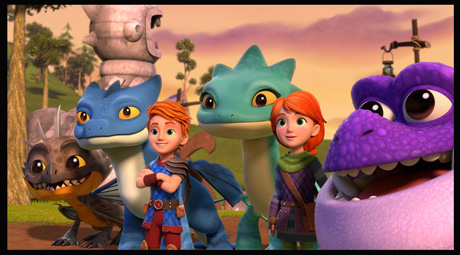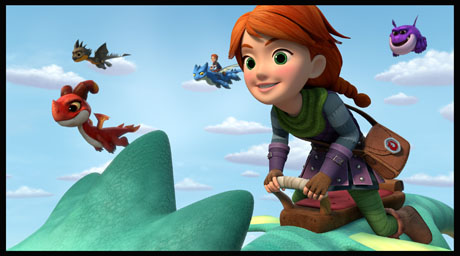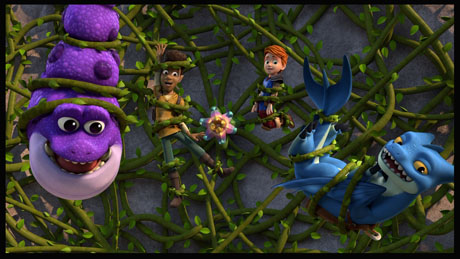
As we wrap-up the first decade of the How to Train Your Dragon saga in pop culture, the folks at DreamWorks are targeting a new demo: young kids. The new animated show Dragons: Rescue Riders is designed to be a starter series for those in Pre-K and elementary school to watch before they’re old enough for the more intense “Dragon” movies. Rescue Riders Executive Producer Jack Thomas and Co-EP Brian K. Roberts join me for this Q&A:
Jack Thomas: The idea was to take the world and the DNA of the franchise and create a new type of storytelling aimed at a younger audience. That’s why it’s all new characters and all new locations, so that we could make it its own thing.
Jackson Murphy: And what elements did you take from the movies and the other TV series and incorporate into the new show?
Brian K. Roberts: We looked at a lot of the visuals from the movies and from “Race to the Edge” and other TV series and looked at ways that we could interpret that into a brighter, more chunky and a little younger-skewing visual… We created a world that felt younger, while still keying off of some of the same inspirations as the original films.

JM: And because death and violence have been prominent in the “Dragon” movies, did you find yourselves having to be restrained with those aspects?
JT: Yes. Absolutely. We’re a kinder, gentler version. We always like to say that we imply the stakes on our show. If you see a wolf chasing a sheep, you just inherently know that a bad thing is going to happen if the wolf catches a sheep. The wolf, for a child, is like a bully – and the sheep is like another kid on the playground, so you know you want to go in and help. We tried to have a lot of excitement. Even in the title sequence, you’ll see Dak jumps off a cliff and just trusts that his dragon is going to be there to catch him. So we want to keep that excitement but make the stakes a little more mellow.
BKR: I like to call the show “a comedy action comedy”. So the types of stories we’re telling are different in many ways… we’re still very character driven.

Brian K. Roberts
JM: And you see the humor because of the fact that we have [brother and sister] Dak and Leyla talking with the dragons and understanding them. And we’re understanding them, too. I think it’s really cool that this is a first for this saga. And it seems like that element would open the door for many more story possibilities – the fact that these dragons can now speak English.
JT: It’s sort of a limitless sandbox for us to play in. I worked on the other franchise “Race to the Edge”, and we were always suffering this issue of how much you could actually communicate to the dragons. It was actually great for storytelling because, in a sense, in the other franchise because the dragon couldn’t talk, you didn’t know what his motivation might be for doing a certain type of activity. Whereas, in our universe, the dragon could just tell you, “Hey, I’m doing this thing you think is bad because I’m hungry!” So it actually makes our storytelling a little harder.
JM: I’ve interviewed Dean DeBlois a couple of times about the “Dragon” movies. Did he oversee any of the things you guys were doing? Did you ask him for some advice every once in a while?
JT: Dean came in early on. We pitched the show to him. And he gave us some advice on the design, and I think he loaned us one of his designers to give us some ideas – to try to bring the characters a little more into the Dragon world. But pretty much he gave us free hand. He was very hands off.
JM: I look at the human characters and go, “They look so pristine. They’re like porcelain figures.” Did you sort of see that, too when developing the characters?
JT: No. (laughs) BUT… the idea of the look is that you don’t have as gritty a world when you’re doing a show for kids. That’s why they look a little cleaner and simpler. Nobody’s missing a foot. And there are very few scars in our world because we wanted our stories to be more about the characters than the dangers of the world.
JM: And there’s a real symbol when it comes to the lighthouse. The gang is staying in an abandoned one called “The Roost”. To me, a lighthouse represents something that not only guides you but it’s really strong, tall and powerful. What is the significance of this lighthouse for you guys and for these characters?

JT: Well, you totally got it. You answered your own question. That’s exactly what the lighthouse represents to us. It’s a beacon. It’s this place that can guide you. And it’s a place of safety. And you totally hit on why we picked that as our imagery.
JM: Awesome. Did you have a hard time choosing what you wanted that symbol to be, or was it always going to be an abandoned lighthouse?
JT: It was sort of a happy coincidence that we were trying to find something that seemed prominent and something that you could perch up on top of. And I think Brian came up with the lighthouse, and I thought it was just perfect.
BKR: The original pitch for the show called for them to have this home base. It didn’t really specify what that was. So Jack and I and the art director, David Chung, worked together to figure out… “What would be a really cool, iconic, powerful image that’s not just a whole in a stone wall or a hut something?” And interestingly, when we first designed it… the whole show we’ve really had an eye towards making things fun and kid-friendly. We first designed it with a slide going around the outside, and Margie Cohn (first the head of DreamWorks TV, now the head of all of DreamWorks) said, “No! Slides are too cliche. Do something cooler like a zip line!” So that’s where the zip line element came in, which we’ve had a lot of fun with in many of the episodes.

Jack Thomas
JT: Yeah. I think we early on sort of knew what archetype characters we wanted. We wanted Winger to be that Captain America-type dragon who’s very forthright. Aggro… the orange dragon of course goes with fire. You just look at the design of Burple, the big purple dragon, and you know he’s going to be a lovable, cuddly guy. Summer was probably the biggest surprise for us. She has developed into sort of the brainiac of the group. She’s the smartest of the characters. And it came late in the development process to give her this “Sherlock Holmes” detective ability.
JM: And in the first episode there’s a nice theme about business and doing good deeds and that life isn’t all about money. Life is about doing good for others. What inspired that to be a main theme for this first episode of the series?
JT: We liked the idea of having a character, Magnus Fink, who is the antithesis of our heroes. He doesn’t have any respect for nature, and they do. He is a genius. If he wanted to give to the town, he’d be the greatest hero in the town. But his weakness is that he’s always trying to do it for money, whereas our guys will do it because it’s the right thing to do.
BKR: The overarching theme of our show is coming together and working together as a team. And so it was really natural for our first episode to reflect that community building idea.
JM: For a fun show aimed at kids, I think it’s a nice, mature theme for kids to think about and maybe talk with their parents.
JT: Thanks. I think the other thing that is much more subtle, but we try to weave into the show, is that our main, core cast of characters will disagree with each other in episodes. And that doesn’t end their friendships. I have a 10-year-old, and it always bugs me that she’ll have an argument with one of her buddies – and then that’s it. They’re dead to each other. (laughs) It’s the end of the world – they’ll never be friends again. And then three days later, of course, they’re friends again. And I wanted to show… that you can disagree with people and still remain friends with them. And that’s a big part of our show. They’ll disagree on how they can solve a problem, but they still, in the end, love each other. They’re all friends.

JM: So as we enter the next decade of the “Dragon” franchise, how do you see these characters going into it?
JT: I hope that what we’re doing with these characters is introducing a new, younger audience to the main franchise. I think it’s sort of funny in a way that for some of the young kids who watch this, they’ll see this before they see the “How to Train Your Dragon” movies. So this will be their starter. And they’ll go, “Oh my gosh! This is a fun world.” And as they get a little bit older, they’ll discover the movies and the other TV shows, and they’ll go, “Oh my gosh!” They can grow with the franchise as they become more mature.
JM: Are there going to be little nuggets of Hiccup or Toothless in some of these episodes?
JT: I would say this: if you’re a fan of the franchise, and if you watch carefully, you will see Easter Eggs. But I’m not going to give you clues on where they are or what they are. (laughs) I love the main franchise. I did 78 episodes of “Race to the Edge” and before that “Defenders of Berk”. It’s really important to me that we fit in even though we are a very different aspect of the main franchise. So there are references.
- INTERVIEW: “Inside Out 2” Director And Producer On Pixar Sequel - April 16, 2024
- INTERVIEW: “Puffin Rock And The New Friends” And 25 Years Of Cartoon Saloon - April 10, 2024
- INTERVIEW: “Chicken For Linda!” Directors On Annecy Winning Feature - April 9, 2024


 September 26th, 2019
September 26th, 2019  Jackson Murphy
Jackson Murphy  Posted in
Posted in  Tags:
Tags: 






